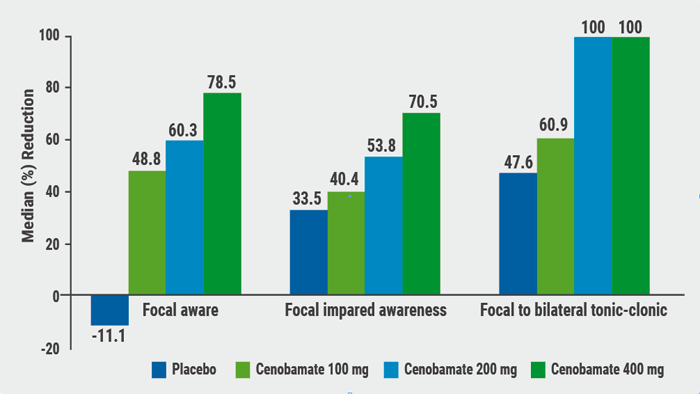The 2 pivotal trials were named C013 and C017. They enrolled adult patients with uncontrolled focal onset seizures (FOS) with ≥3 seizures per month (C013) or ≥8 seizures per 8 weeks (C017). Participants also used 1-3 concomitant anti-epileptic drugs. In C013 they were randomised to cenobamate 200 mg/day or placebo; in C017 to cenobamate 100, 200, or 400 mg/day, or placebo. Response was defined as ≥50% reduction in seizure frequency from baseline.
In C013, responder rate in the maintenance phase was significantly higher for cenobamate 200 mg versus placebo (62% vs 33%). Seizure freedom rate was significantly higher as well (28% vs 9%). In C017, ≥50% responder rate during maintenance was significantly higher for all cenobamate dosages (100 mg, 40%; 200 mg, 56%; 400 mg, 64%) versus placebo (26%). In the 200 and 400 mg groups, significantly higher rates of patients achieved seizure freedom (11% and 21%, respectively) versus placebo (1%).
There was a significant reduction across all subtypes of FOS in actively treated patients in both C017 (see Figure) and C013, in which reductions in seizure frequency with cenobamate versus placebo in the maintenance phase were:
- Focal aware (91.5% vs 46.5%);
- Focal impaired awareness (62.0% vs 27.6%);
- Focal to bilateral tonic-clonic (100.0% vs 53.0%).
Cenobamate was generally well tolerated. The most frequently occurring AEs (≥10%) were dizziness, somnolence, headache, fatigue, and diplopia.
Figure. Percent reduction in seizure frequency by seizure type in the maintenance phase (C017 study) [1].

- Steinhoff BJ, et al. Abstract O3006, EAN 2020.
Posted on
Previous Article
« Sustained seizure reductions with cannabidiol for Lennox-Gastaut syndrome Next Article
How genetic testing can contribute to epilepsy management »
« Sustained seizure reductions with cannabidiol for Lennox-Gastaut syndrome Next Article
How genetic testing can contribute to epilepsy management »
Table of Contents: EAN 2020
Featured articles
Alzheimer's Disease and Other Dementias
Non-Alzheimer’s disease pathophysiology in the elderly
Novel genetic association with resistance to ERC tau deposition
Diastolic dysfunction novel risk factor for cognitive impairment
Epilepsy
Avoidable epilepsy-related mortality remains high
How genetic testing can contribute to epilepsy management
Cenobamate effective in focal epilepsy
Sustained seizure reductions with cannabidiol for Lennox-Gastaut syndrome
Prevalence of autoantibodies in epilepsy almost 10%
Parkinson's Disease
White matter matters in Parkinson’s disease
Sleep disorders mark PD progression
Directional DBS superior to omnidirectional DBS
Stroke
Benefits of statins to prevent stroke outweigh risks
Extubation after thrombectomy: the sooner, the better
Thrombus location and length predictors of early neurological deterioration
Endovascular treatment in large vessel occlusion stroke patients treated with OAC
Early edoxaban may be safe after cardioembolic stroke
Headache and Pain
Small fibre pathology as biomarker for fibromyalgia
Migraine as a cyclical functional disorder
Reassuring real-world safety profile of 3 CGRP inhibitors
Long-term cardiovascular safety of erenumab
Real-world data for erenumab in Germany
Eptinezumab in chronic migraine and medication-overuse headache
Fremanezumab tolerability in cardiovascular patients with migraine
Effects of galcanezumab on health-related quality of life
Multiple Sclerosis
Imaging to evaluate remyelination and neuroprotection
Serum NfL predicts long-term clinical outcomes in MS
Epstein-Barr virus-targeted T-cell immunotherapy for progressive MS
High NEDA rates after 2 years of ocrelizumab
Switching from natalizumab to moderate- versus high-efficacy DMT
Results of compounds in late stages of development
Alemtuzumab efficacy and safety data of over 9 years
Fampridine treatment results in routine clinical practice
Air pollution is a possible risk factor for MS
Neuromyelitis Optica Spectrum Disorder
Genetic association studies in NMOSD needed
Eculizumab in NMOSD: the PREVENT study
Long-term safety of satralizumab consistent with double-blind periods
Neuromuscular Disorders
Biomarkers predicting motor function in SMA
Sustained benefits of avalglucosidase alfa in late-onset Pompe disease
Efficacy and safety of rituximab in refractory MG corroborated
Related Articles
September 10, 2020
Alemtuzumab efficacy and safety data of over 9 years
![Table. ATN-profiles and corresponding biomarker categories [3].](https://conferences.medicom-publishers.com/wp-content/uploads/2020/09/Table.-ATN-profiles-and-corresponding.png)
September 8, 2020
Non-Alzheimer’s disease pathophysiology in the elderly
September 10, 2020
Eculizumab in NMOSD: the PREVENT study
© 2024 Medicom Medical Publishers. All rights reserved. Terms and Conditions | Privacy Policy
HEAD OFFICE
Laarderhoogtweg 25
1101 EB Amsterdam
The Netherlands
T: +31 85 4012 560
E: publishers@medicom-publishers.com

